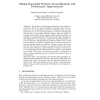Free Online Productivity Tools
i2Speak
i2Symbol
i2OCR
iTex2Img
iWeb2Print
iWeb2Shot
i2Type
iPdf2Split
iPdf2Merge
i2Bopomofo
i2Arabic
i2Style
i2Image
i2PDF
iLatex2Rtf
Sci2ools
163
click to vote
ICDE
1995
IEEE
1995
IEEE
Mining Sequential Patterns
Abstract. The problem of mining sequential patterns was recently introduced in 3 . We are given a database of sequences, where each sequence is a list of transactions ordered by transaction-time, and each transaction is a set of items. The problem is to discover all sequential patterns with a user-speci ed minimum support, where the support of a pattern is the number of data-sequences that contain the pattern. An example of a sequential pattern is 5 of customers bought `Foundation' and `Ringworld' in one transaction, followed by `Second Foundation' in a later transaction". We generalize the problem as follows. First, we add time constraints that specify a minimum and or maximum time period between adjacent elements in a pattern. Second, we relax the restriction that the items in an element of a sequential pattern must come from the same transaction, instead allowing the items to be present in a set of transactions whose transaction-times are within a user-speci ed t...
Database | Generalized Sequential Patterns | ICDE 1995 | Mining Sequential Patterns | Sequential Patterns |
Related Content
| Added | 01 Nov 2009 |
| Updated | 01 Nov 2009 |
| Type | Conference |
| Year | 1995 |
| Where | ICDE |
| Authors | Rakesh Agrawal, Ramakrishnan Srikant |
Comments (0)

